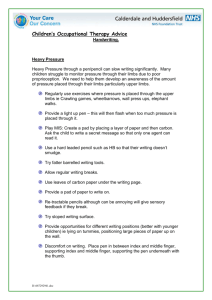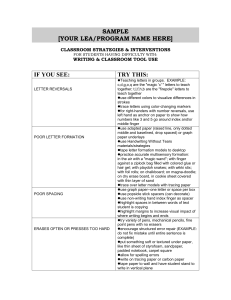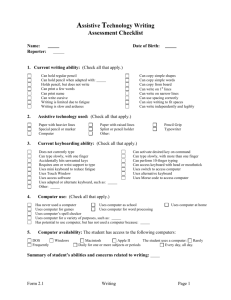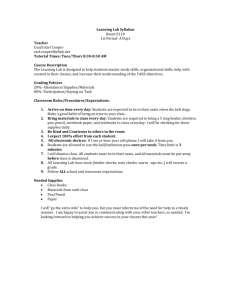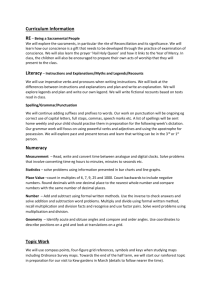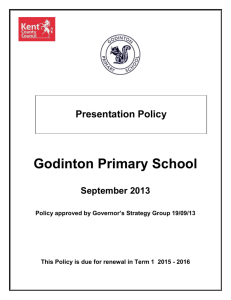Ready, Steady, Write
advertisement
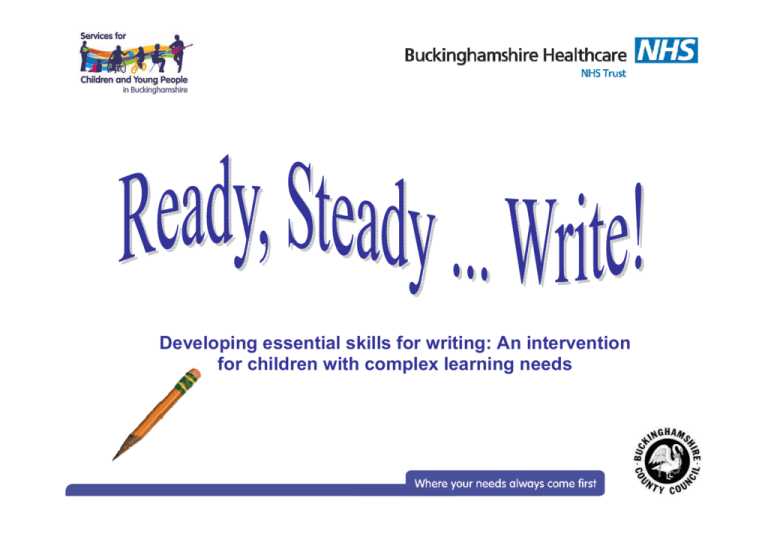
Developing essential skills for writing: An intervention for children with complex learning needs Foreword Ready, Steady ... Write! was established through the positive blending of two professional services - Down syndrome Support Team, Specialist Teaching Service and the Paediatric Occupational Therapy Service, working to complement expertise in specialist fields. Special thanks go to Julie Hooton (Specialist Teacher for Children with Down Syndrome) and Catriona Johnstone (Specialist Paediatric Occupational Therapist) for their input into the programme, and to Fiona Thompson from Symbol UK Speech and Language Therapy Service for her help with the auditory attention and memory section. Please refer back to the Paediatric Occupational Therapy Service or the Down Syndrome Support Team, Specialist Teaching Service for future updating of the document, so that it can be of benefit to others. Paediatric Occupational Therapy Service Oakridge Centre 240 Desborough Road High Wycombe Bucks HP11 2QR Tel: 0844 2252389 Specialist Teaching Service Wycombe Area Office Easton Street High Wycombe Bucks HP11 1NH Tel: 01494 475199 1 Page 3 Introduction 5 Instructions for Use 7 Week 1 Record sheet 8 Week 2 Record sheet 9 Week 3 Record sheet 10 Week 4 Record sheet 11 Week 5 Record sheet 12 Week 6 Record sheet 13 Essential Skill Area 1 - Core Stability 15 Essential Skill Area 2 - Pen/ Pencil Grasp 17 Essential Skill Area 3 - Auditory attention and memory 18 Essential Skill Area 4 - Visual Perception 20 Essential Skill Area 5 - Writing Patterns 23 Appendix 1 - Good Practice Tips and Strategies 24 Appendix 2 - Resources 2 Introduction Ready, Steady ... Write was developed for children and young people with complex learning needs who struggle to acquire the essential skills necessary, to be able to write by hand and to make written progress in all curriculum areas. Through use of this programme, children and young people will improve their ability to produce fluent, spontaneous and legible handwriting. Handwriting is a complex skill which requires the integration of a large number of skills. It has been developed for children and young people with Downs Syndrome, but will also benefit children with a range of other educational needs. This is a working document aiming to develop 5 areas of skill. These need to be practised regularly, some areas more than others, depending on the child. These 5 areas are: 1 - Core Stability Wake up the body Imagine a crane on a building project, the long arm can only function if the base is stable. In the same way a child’s hand can only produce neat handwriting if the rest of the body is stable enough to allow for it. 2 - Pen/Pencil Grasp and Fluidity of Movement Strengthen the hand. The arches in the hand provide stability for action. A child must have sufficient strength and stamina in the intrinsic muscles of the hand to allow for holding and skilfully manoeuvring the pen or pencil. 3 3 – Auditory (Listening) Attention and Memory 4 - Visual Perception Tune in the ears Remember that memory is not a muscle but does respond to strengthening in the same way as the hands. The ability to process, discriminate and retain auditory information is essential to appreciating the relevance of communicating through writing. Focus the eyes Although our eyesight may be good, learning to form letters requires interpreting correctly what is seen, for example, distinguishing between a vertical line and a diagonal line, an ‘a’ and ‘c’. 5- Writing Patterns (inc letter formation) and W R I T E ! Often the teaching emphasis and expectations are on the writing patterns when in fact other skills have not been acquired and are not functioning effectively in order for writing patterns and letter formations to take place. 4 Instructions for use Refer to pages 13-22 which detail the 5 essential skill area activities. Choose 1 activity from each essential skill area. The chosen activity from each essential skill area is to be practised daily for a week. All 5 activities should last approximately 10 minutes per day in total, with other pupils included within a group wherever appropriate in order to maximise inclusion. Record progress daily on the sheet provided, Pages 7-12. It is recommended that feedback from each activity is included, with references to achievements, strengths and possible areas for future reinforcement. Each week these activities are changed and the intervention should be planned to last 6 weeks, then evaluated for future planning with a clear understanding of building on success, sensitively identifying weaknesses or gaps in skill development and reinforcing as necessary. When planning consider carefully the sequence of activities, for example, some gross motor core stability practice may be far more appropriate to develop thoroughly in the early stages leading to fine motor pencil grip practice. Wherever possible, the activities have been put into hierarchical order in each section in order to help in this choice. Keep activities as meaningful and enjoyable as possible, incorporating them into relevant class work and Speech and Language Therapy tasks if appropriate. When working with older pupils, careful planning is needed to ensure the activities are appropriate or modified to be age appropriate. It is recommended that a store in the form of a box or crate is made available with all planned and required resources ready for each week’s activities. 5 Hand strengthening resources can be stored in a separate box to form a ‘hand gym’ for regular access by the child to build up strength. This can be especially useful when they have worked out their hand dominance (i.e. left or right handed), as more emphasis can be placed on strengthening the hand likely to be used for writing. At the end of each essential skill area, spaces have been left by educational staffs to add tips, activities and resources which from experience have worked well. Parents should be consulted and, where appropriate, involved in supporting the learning and development of their child as an integral part of this intervention. To maximise inclusion in school time, it may be worthwhile for some of the activities to be reinforced at home by parents. NB Every time we perform a particular motor sequence or movement, the neural pathway (the connections made between the brain and the muscles involved) is reinforced again and again. We get better at performing the eventually embedded movement which develops in a continuous process from birth to adulthood. Teachers may wish to use this in conjunction with the PIVATS (English-writing) to establish a baseline for assessment and monitor progress. This can be found using the following link www.lancashire.gov.uk/education/pivats 6 Record Sheet Name: Start Date: WEEK 1 ACTIVITY (these 5 ESSENTIAL SKILL AREA Core Stability Pen/Pencil Grasp Auditory Attention/ Memory Visual Perception Writing patterns √ activities should be practised daily & in total should last approx. 10 minutes) when completed FEEDBACK/COMMENTS for future planning M T W Th F M T W Th F M T W Th F M T W Th F M T W Th F 7 Record Sheet Name: Start Date: WEEK 2 ACTIVITY (these 5 ESSENTIAL SKILL AREA Core Stability Pen/Pencil Grasp Auditory Attention/ Memory Visual Perception Writing patterns √ activities should be practised daily & in total should last approx. 10 minutes) when completed FEEDBACK/COMMENTS for future planning M T W Th F M T W Th F M T W Th F M T W Th F M T W Th F 8 Record Sheet Name: Start Date: WEEK 3 ACTIVITY (these 5 ESSENTIAL SKILL AREA Core Stability Pen/Pencil Grasp Auditory Attention/ Memory Visual Perception Writing patterns √ activities should be practised daily & in total should last approx. 10 minutes) when completed FEEDBACK/COMMENTS for future planning M T W Th F M T W Th F M T W Th F M T W Th F M T W Th F 9 Record Sheet Name: Start Date: WEEK 4 ACTIVITY (these 5 ESSENTIAL SKILL AREA Core Stability Pen/Pencil Grasp Auditory Attention/ Memory Visual Perception Writing patterns √ activities should be practised daily & in total should last approx. 10 minutes) when completed FEEDBACK/COMMENTS for future planning M T W Th F M T W Th F M T W Th F M T W Th F M T W Th F 10 Record Sheet Name: Start Date: WEEK 5 ACTIVITY (these 5 ESSENTIAL SKILL AREA Core Stability Pen/Pencil Grasp Auditory Attention/ Memory Visual Perception Writing patterns √ activities should be practised daily & in total should last approx. 10 minutes) when completed FEEDBACK/COMMENTS for future planning M T W Th F M T W Th F M T W Th F M T W Th F M T W Th F 11 Record Sheet Name: Start Date: WEEK 6 ACTIVITY (these 5 ESSENTIAL SKILL AREA Core Stability Pen/Pencil Grasp Auditory Attention/ Memory Visual Perception Writing patterns √ activities should be practised daily & in total should last approx. 10 minutes) when completed FEEDBACK/COMMENTS for future planning M T W Th F M T W Th F M T W Th F M T W Th F M T W Th F 12 Essential Skill Area 1 - Core Stability Wake up the body No 1 2 3 4 5 6 7 Activity Tips Stand on one leg and balance. Children tend to like “animal” reference e.g. Progress to hopping using different flamingo. legs Alternatively if too advanced, practise balance by asking child to kick a ball. Cat drinking milk (more appropriate Child pretends to be a cat and crawl along on for younger children) all fours to a pretend bowl of milk, then lowers head and shoulders to drink the milk. (This is a good activity for developing shoulder stability for writing). Throw beanbag into a target e.g. To grade you can increase distance between hoop child and target and size of target (e.g. hoop down to washing-up bowl). Ensure majority success! Walk along a given line forward and Use lines on playground to initiate activity if backwards, then knee walk along the it helps. line forwards and backwards Imaginary lines may be used if child is able. Walk up and downstairs using one Try holding then not holding foot per step Touch named parts of the body Try eyes open then eyes closed (you may be amazed at how challenging this is with eyes closed) Mirror movements of a partner using Child may feel happier to lead this initially flags Start with one flag and progress to a flag in each hand. Resources Beanbag, bowl hoop, washing up Masking tape on floor Flags 13 8 9 10 11 Move around the room stop dead on Use tambourine and beater to give stop command command. If child finds this difficult provide a boundary by asking child to run along a line and freeze on a carpet tile. Using ribbons, child and partner The ability to draw these shapes is a predraw a given shape in the air with requisite to handwriting. large movements You could give the child the shape verbally or e.g. a long horizontal line, a vertical draw a picture of it on a line, a circle, a square, a triangle, a chalkboard/whiteboard. It may be more zigzag, a letter motivating to allow the child to take turns at drawing the shape for a partner to copy. Link to art, PE, music. Walking using corded stilts Child often needs time to learn how to pull up the cord attached, to be able to walk. Cross lateral marching Start with just legs marching, once confident add arms swinging. Then progress to touching opposite knee with hand whilst marching. Tambourine and beater Lengths of ribbon A chalk board and small chalk/ whiteboard and marker Corded Stilts 14 Essential Skill Area 2 - Pen/ Pencil Grasp Strengthening the hand No 1 2 3 4 5 Activity Tips Use empty squeeze bottle to blow Encourage hand stability. ping pong balls across a table Have a race. Can use a mapped track on large scale. Use 5 pegs to peg onto a ‘flowerpot’ Ensure child uses tip of index (or middle finger) or cardboard leaf, for example. and thumb. Remaining fingers should be curled Remove and re-peg into the palm, you could ask the child to hold a coin in the palm of their hand using their other fingers. Pegs decorated with flowers, ladybirds e.t.c. can be more motivating. Be aware of stiff pegs and grade accordingly. Try numbered pegs. Link to mathematical vocabulary, above, below, to the right/left. Try clipping animals e.g. koalas clipped on thick card branches with specific places to clip. Using therapeutic putty Roll out into a sausage “pinch” all the way along using the tip of a different finger and thumb Roll putty into a ball and push each finger into the centre in turn, keeping finger straight Using therapeutic putty hide marbles If marbles not appropriate for child use small in putty for child to extract motivating toy which child particularly likes. Popping bubble wrap with finger and Progress to a cut out line of 4 bubbles popping thumb each in turn with a different finger in sequence. Resources Washing up liquid bottle that child can easily squeeze. 5 pegs 2 pots (flower pots work well) Cardboard leaf Red Therapeutic (medium strength) putty Red Therapeutic putty Bubble wrap 15 6 7 8 9 10 Open lid and find surprise Encourage child to use both hands working together to stabilise box (bi-lateral co-ordination). Encourage child to use non-dominant hand to stabilise the box. Use fingers and thumbs to open and close lids. Use pots for colour, number, phonic (initial – medial or end) word matching. Match lids to a selection of boxes/lids. Flick ball or screwed up paper ball Children tend to flick their whole hand initially. across a table When working with a child with Down syndrome he/she may automatically pick up the ball and throw it! Use thumb and index (or middle) finger to flick and the remaining fingers to be curled into palm of hand. Put a sticker on the finger nail to highlight which finger to use Make trees using triangular / Try asking child to select pieces of the same rectangular / cloud shaped card / colour or pieces to be joined in order of size. foam with spaced holes and linking with treasury tags. Pick up cotton balls using tongs If appropriate progress to picking up beads and possible using tweezers. Bead threading Provide pattern cards which could be ordered in shape, colour or both and ask them to match the sequence as they thread. Link to mathematics Use cut up plastic drinking straw and finer thread to make it more challenging Create own beads from dough, clay or rolled paper. Selection of small boxes/jars/pots with lids Plastic Pill box (7 days of the week box is useful) Card Foam Treasury Tags Beads and thick laces Pattern Cards Drinking straws Thread 16 Essential Skill Area 3 - Auditory Attention and Memory Tune in the ears No 1 2 3 4 5 6 7 8 9 Activity Tips Resources Tap a rhythm and child copies it Lay out coloured cubes in response Coloured cubes/multi-link to oral instructions Carry out a sequence of instructions, Eg “ Can you go and get your bag” increase the number of elements Link to Speech and Language Therapy targets where appropriate Lay out named cards. After 2 have Bingo Cards been named, increase number. “I packed my bag, and in it I put…..” Alternatively “I went to the shops and game. bought…” Child tries to remember sequence. Practise days of the week. Often singing the sequence helps. Numbers 1 – 19 Sunday, Monday, Tuesday, Wednesday, Alphabet Thursday, Friday Saturday too 1, 2, 3, 4, 5, 6, 7 days, each day different and everyday is new Name 2 objects on a picture before Appropriate picture child sees it. Child circles objects. Follow instructions, for example “Put the beanbag on your head, lie on your back and touch toes etc” Play Simon Says eg “Simon says touch your right ear….” 17 Essential Skill Area 4 - Visual Perception Focus the eyes No 1 2 3 Activity “Matching” ONE of the following: 3D Objects Simple 2D Pictures Colours Name Words Individual Letters Tips The child must be able to understand the concept of match i.e.” same” and “different”. E.g. two red cars and a red aeroplane. Resources Objects to match Try lower case magnetic letters in a bowl of water for the child to pick out to match (This can be a good motivator and learning is likely to be memorable as it includes a sensory element) Dot to dot Keep to few dots initially then extend Sticky dots Using sticky dots encourage child to Always start on the horizontal and progress Mark maker place dots on the paper. Then child to vertical and a mixture. joins the dots up using finger and then a mark maker Copy patterns of increasing Use coloured cubes (all same colour) and child 12 Cubes complexity (3D) copies eg 4 Practise sight words on flash cards Sight words on flash cards 5 Sorting colour Sorting objects activities, shapes, size, E.g. Compare bears are popular 18 6 Homemade Picture puzzles 7 Kim ‘s memory game 8 Feely bag game 9 Lotto game Take a motivating picture. Cut it into A picture quarters and child positions together. To make this easier allow child to place the pieces onto the original picture. To make the task more difficult cut the picture into more parts. Progress to hiding two objects Tray Cover objects Grade according to child’s ability. Show items Objects first (e.g. car, ball, rubber ) Bag Emotional Lotto Lotto 19 Essential Skill Area 5 - Writing Patterns and W R I T E ! No 1 Activity Copy pre-writing shapes using one of the following: - tracing in a sand tray, - tracing in shaving foam/paint, - writing with chalk on chalk board. - Pencil and paper Tips The ability to draw these shapes is a prerequisite to handwriting. 2 Motor control with magnets Laminate a blank sheet of paper and draw desired lines with a marker; place one magnet on the top at the starting point and hold second magnet under the paper Child moves the bottom magnet and watches the top magnet move along the desired path For the desired lines, start with a horizontal line, progress to vertical and then curved path. If child is able, move onto letter patterns using appropriate letter formation pathways. It may be worthwhile to mark achievable desired paths on paper and laminate as a permanent resource for practice. 3 Motor control in a boundary 4 Resources Use small pieces of chalk approximately 3cm to encourage a tripod grasp. 2 magnets Laminated paper Marker Ladybird/interesting magnets Child uses a marker to draw within the given Clear View + cards pathway Mazes Teodoresou booklets Name Use sandpaper letters to practise letter Run finger over sandpaper or tactile formation or buy “tactile letters”. This Sandpaper letters or tactile letters in correct letter formation provides support to learn how to form the letters – see resource list pathways letter rather than merely copy writing. If tactile defensive try other textures, e.g. pink fur is appealing. 20 5 6 a, c, d, g, o, q, Letters of name may be tackled individually as there may be more success from learning out of order alongside sandpaper complete name. Start with easiest letter first and shorter name if possible, to get success. Trace letters using sand, shaving foam, paint, scented tea leaves etc. Try surface finger painting chalk wet-dry-try technique(see 7) sponge drawing, try again dry, then try pencil tracing Show starting point of letters using red dot. Think BIG e.g. 2cm A4 squared paper – write on the line. This allows the child to judge where to start, helps to get space in between, use vertical lines i.e. more than a finger space between letters. Use computer keyboard reinforcement for letter recognition. Sand Sandpaper Shaving foam Chalkboard Squared Paper NB For a child with Down syndrome teaching in letter groups may be tricky to synthesize. It may be more appropriate to use high contrasting groups of letters. b, e, f, h, i, j, k, l, m, n, p, r, s, t, u, v, Choose letters to work on. Don’t be tempted w, x, y, z to go too fast as much preliminary work needs to be done before letters can be formed spontaneously. 21 7 CAPITAL letters Chalk wet-dry-try technique i.e. Draw the desired capital letter on the small chalk board with chalk, child rubs it out in the same direction/pattern as it is written with the tiny sponge slightly wetted and squeezed, Child writes over with the small piece of chalk. Use tiny sponges and chalk as this should automatically result in tripod grip. Choose capital letters in name. CAPITAL letters can be easier to synthesise as there are fewer strokes and paths to develop in order to communicate the alphabet text; in special cases it may be that communicating through CAPITALS is the best that can be done. Caution needs to be taken however as ideally developing onto lower case from CAPITALS can prove difficult when CAPITAL letters have become embedded. This is particularly true of children with Down syndrome. Small chalk board Two tiny sponges Small shallow dish of water 3cm piece of chalk 22 Appendix 1 – Good Practice Tips and Strategies Seating tips Straight back Feet flat on the floor or supported on a box. Right angles at the hips, knees and ankles Head in a central position Clearance between the back of the knee and the seat edge, approx 2 finger width. Clearance between the top of the thigh and the table. The table height should be equal to the height of the elbow. Or level with the elbow height when the child places a fist under their chin and keeps their chin in a neutral position A pen can often flow more easily then a pencil. A tripod grip using thumb and first 2 fingers should be encouraged. A variety of commercially produced pencil grips, tripod pens may help achieve this. Experimentation will find the best for each child. A Rubber band wrapped around the pencil shaft, 3 cm from the nib, can form a useful grip. An airflow ball with a pencil pushed through the holes could act as a first step. Remind the child: ‘Feet flat and Bottom Back in the chair’ Some children benefit from using a sloping writing surface. Commercially produced slopes are available, but a ring binder could be trialled initially. 23 Appendix 2 - Resources How does it help? Product Supplier Concentration Weighted lap pad www.sensorydirect.com Description LDA www.LDAlearning.com Personal Timer Sand Timers Posture Taskmaster LDA Special Direct – www.specialdirect.com Sloping board (writing slope) Taskmaster Sunshine Company Special direct LDA Wedge cushion Back in Action Foot block NRS – school chair footrest 24 Interlocking footrest Smirthwaite Handwriting Dycem NRS www.Dycem.co.uk Tactile letters Special Direct Upper and lower case sandpaper letters Amazon 25 Success with Scissors PETA UK Taskmaster Easy grip Scissors Easy Grip Scissors Long loop Scissors Self Opening Scissors Dual Control training Scissors 26 Pushdown Table Scissors Strengthening the hand Therapeutic putty Homecraft Roylan 01623 754047 Independent Living consultants www.specialdirect.com Pencil grip Large Ultra pencil grip Cross Guard Ultra Large Ultra Visual Perception Shape by Shape Cross Guard Happy puzzle company 27 Useful resources/books available: Handwriting without Tears 8802 Quiet Stream Ct., Potomac, MD 20854 www.hwt.com Olsen, Janice Z. Handwriting without Tears printing and writing programme Workbooks and resources. Self-published, 1997 Available from above. Bruni, Maryanne. Fine Motor Skills in Children with Down syndrome: a guide for parents and professionals. Woodbine House, 1998. Teodorescu, Ion and Addy, Lois M. Write from the Start. Developing the fine motor and perceptual skills for effective handwriting. LDA 2001. Rol’n’Write including Handwriting Activity Worksheets. LDA 1991 A Hand for Spelling. LDA 2005 Alton, S. Fine Motor Skills in children with Down syndrome. DSA UK Education Consortium 2005 Mazes. Photocopy Masters for Developing Fine Motor Skills. LDA 1997 Handwriting Photocopy Masters. Collins, 1992 Tyson, J & Toohig, E. Developing skills to support Handwriting. 2007 28 Our handwriting is very personal it is a part of who we are and how we communicate in our world 29

